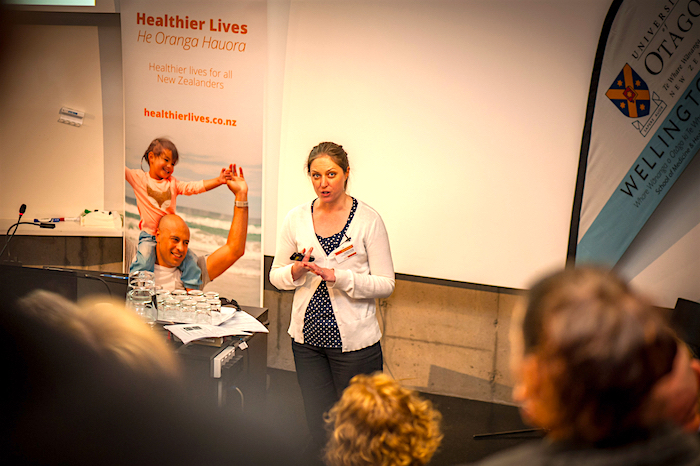HE AHA TĀ MĀTOU I TŪHURA AI
What we investigated
Take | Issue
Almost 1 in 3 deaths in Aotearoa New Zealand are caused by cardiovascular disease (CVD) and around 170,000 New Zealanders are living with the disease. It is estimated that over 250,000 New Zealanders have diabetes, a condition which can lead to heart disease and contribute to CVD deaths.
Early detection of those at high risk of CVD and diabetes enables better treatment and health outcomes.
Since 2007, New Zealand GPs have used a tool for early detection of CVD derived from a North American population. Māori, Pacific and South Asian people have significantly higher rates of CVD and diabetes than New Zealand Europeans. So the tool underestimated risk for these ethnic groups.
The tool currently available to GPs for early detection of diabetes also requires updating.
Whāinga | Aim
This project aimed to improve early detection of people at risk CVD and diabetes by:
-
-
- producing and testing new equations capable of accurately predicting CVD and diabetes risk for the ethnically diverse New Zealand population, and
- identifying the factors which either protect patients who have coronary heart disease or place them at risk of incurring a secondary event.
-
Huarahi I Whāia | Approach
The research team took a two-pronged approach:
-
-
- In one of the largest ever studies of its kind, researchers analysed linked national health data from more than 400,000 New Zealanders (including 55,000 Māori, 55,000 Pacific and 35,000 people of South Asian descent) to investigate the association between risk factors and CVD health outcomes
- A cohort of 2,000 patients admitted to hospital following a first heart attack was recruited. It has better representation of Māori and Pasifika than any similar previous study. A broad range of in-hospital and lifestyle data is currently being collected.
-
NGA PUTANGA ME TE PĀNGA
Outcomes and Impact
Putanga | Outcome
The research team developed revised CVD risk assessment equations with ethnic-specific variables. This research was published in the prestigious international journal, The Lancet. The new risk scores were incorporated into national guidelines issued by the Ministry of Health in February 2018.
These improved CVD risk equations will help GPs to manage risk factors for their patients more equitably across all ethnic groups.
The research team also investigated whether CVD risk equations would adequately characterise diabetes risk but results showed that new equations will be required.
Valuable data from the cohort of 2,000 heart attack patients admitted to hospital following a first heart attack is still being collected. It will inform future clinical practice by supporting a more targeted and equitable approach to secondary prevention in patients with coronary heart disease.
Te Ara Kei Mua | Next Steps
The research team has developed preliminary models for predicting diabetes risk amongst people whose level of HbA1c (glycated haemoglobin, a measure of blood glucose levels) is below the threshold for diagnosing diabetes. Development of a comprehensive model is the next step.
Data from a subset of the large cohort of patients will be used in Healthier Lives’ epigenetics research.
Nga Hua O Te Rangahau | Research Products
The new CVD risk equations have been incorporated into national guidelines:
-
-
- HISO 10071:2019 Cardiovascular Disease Risk Assessment Data Standard. Ministry of Health (2019)
- Cardiovascular Disease Risk Assessment and Management for Primary Care. Ministry of Health (2018)
-
WHAKAWHITI MŌHIOTANGA
Knowledge Exchange
Puka Rangahau | Academic Publications
-
-
- Cardiovascular risk prediction in type 2 diabetes before and after widespread screening: a derivation and validation study. The Lancet (2021)
- The Multi-Ethnic New Zealand Study of Acute Coronary Syndromes (MENZACS): Design and Methodology Cardiogenetics (2021)
- Ethnic differences in cardiovascular risk profiles among 475,241 adults in primary care in Aotearoa, New Zealand. New Zealand Medical Journal (2020), 133:1520
- Cardiovascular disease risk prediction equations in 400 000 primary care patients in New Zealand: a derivation and validation study. The Lancet (2018), 391(10133), 1897–1907
- Living in areas with different levels of earthquake damage and risk of cardiovascular disease: a cohort-linkage study The Lancet Planetary Health (2017) 1:6 e242–e253
-
Pāpāho | Media
-
-
- Māori, Pasifika and South Asians at greater risk of cardiovascular disease – study Radio NZ, May 2018
- Paramedic who suffered heart attack on the job takes part in groundbreaking study Stuff.co.nz, January 2018
- Earthquakes literally broke hearts in New Zealand Reuters Health, September 2017
- “Professor Predict” and his algorithm for calculating your heart attack risk and treatment Noted, October 2016
-
Kōnae Whakaata | Video
-
-
- Allamanda Faatoese, a stakeholder perspective, YouTube (1m55s), July 2018
- Te Papa Hauora’s We’re talking health… ‘Averting the Grim Reaper’ Vimeo (10m 14s), June 2018
-





















